
Satellite lesions are usually associated with Candidainfections but not with Bowen disease.

Satellite lesions are usually associated with Candidainfections but not with Bowen disease.
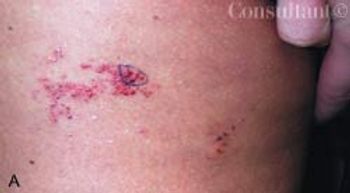
For 10 years, a 22-year-old woman had had an erythematous, translucent patch of grouped blisters on her left thigh. A recent increase in the size of the patch prompted the patient to seek treatment. There was no burning or tingling at the site. The patient reported that the erythema occasionally cleared; however, the blisters always remained. She denied fever, weight loss, and other constitutional symptoms.
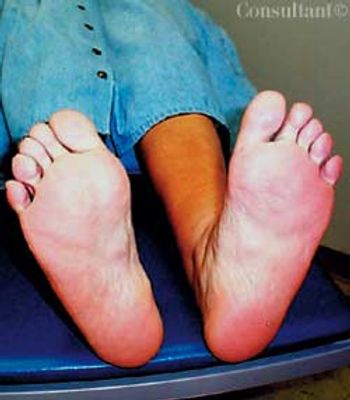
Asymptomatic, enlarging growths had been present on the bottom of a 56-year-old woman’s feet for 3 years. The nodules initially arose-first on the left foot, then on the right-at the sites of blisters on the insteps after the patient had taken a long hike in uncomfortable boots.
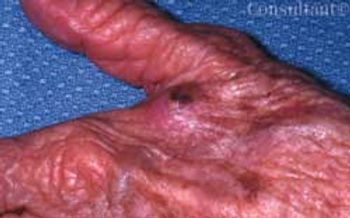
An 87-year-old woman sought treatment of what she described as a “bite” of 1 month’s duration. The pink, nodular lesion on the dorsum of the left hand had central superficial ulceration with yellow crusting at the web space between the thumb and index finger.

A Young Boy With High Fever and LethargyA 5-year-old boy is brought to the emergency department(ED) by his parents. They report that, for thepast week, the child has had a high fever (temperatureup to 40oC [104oF]), generalized weakness, lethargy, andlack of appetite. The boy’s eyes are bloodshot and he hasrefused food and drink. The child has no history ofcough, shortness of breath, hematemesis, melena, headaches,vision problems, or seizures. He has not been incontact with sick persons, has not traveled abroad, doesnot have a pet, and is not taking any medications. His immunizations are up-to-date.
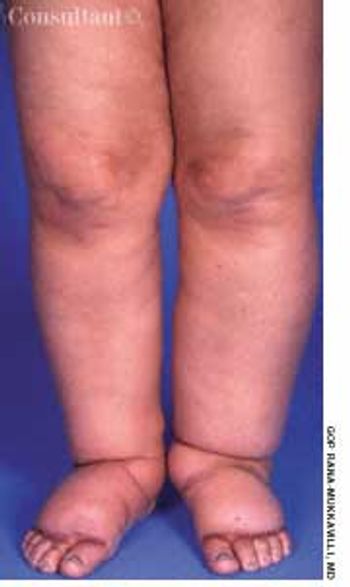
For 2 months, a 47-year-old woman experienced constipation, weakness, fatigue, and dry skin. She also complained of moderate weight gain and menorrhagia during the same period. The patient took no medications and denied any allergies.

Primary care providers are seeingan increasing number ofpatients who have snakes orbarbwire coiling around theirarms or gold rings danglingfrom their eyebrows and navels. Tattooingand body piercing are particularlypopular among adolescents andyoung adults-many of whom may notbe aware of the possible medical complicationsof these ancient practices.

Three carbon dioxide laser treatments were used to remove a 35-year-oldwoman’s tattoo (A). Four months after the procedures, significant scarringwas noted at the site (B).

Postoperative inflammation occurred shortly after this25-year-old woman’s earlobes were pierced. Within a fewmonths, bilateral keloids developed at the sites. Thekeloid on the left ear is shown here.

After exposure to the sun, an erythematous, edematous, pruritic allergicreaction developed at the site of a 22-year-old man’s new tattoo. In additionto photoallergy-as seen in this patient-direct allergy to the dyes in thetattoo can produce an adverse reaction.

A 7-year-old black girl comes toyour office with a 10-week historyof scaling and scalp redness,and hair loss. About 3 weeks beforethe visit, the child’s motherfirst noticed a boggy, drainingyellow plaque on her daughter’sparietal scalp. A different physicianprescribed ketoconazoleshampoo. At 1-week follow-up,the symptoms had not abated;the clinician then prescribed oralcephalexin as well as a topical mixture of the antifungal agent, clotrimazole, and the high-potency topicalcorticosteroid, betamethasone. After 2 weeks of therapy, the symptoms were no better.
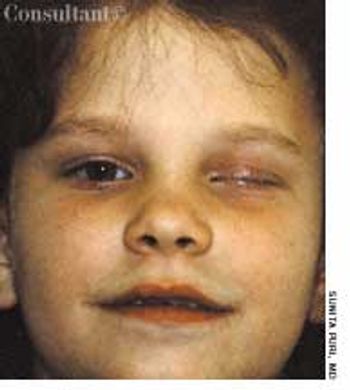
The upper and lower eyelids of a 6-year-old girl were stuck together after she accidentally splashed superglue in her left eye. The patient did not complain of pain; the eyeball was able to move freely under the lids.

The mother of a 6-year-old child brings her to your office becauseof a pruritic rash that has been present for several days. The rash did not respondto hydrocortisone cream and has continued to spread along the patient’sleft side.

My patient is a 42-year-old woman who experienced a nonblanching, purpuricrash and edema of the lower legs after she started taking nifedipine (Figure).
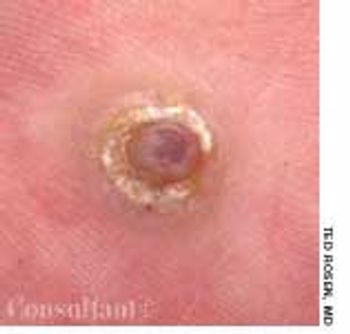
A 32-year-old man who was seropositive for HIV presented with a tender lesion on his right foot of about 3 months' duration. The patient's only medication was zidovudine. His CD4+ cell count was 120/µL.
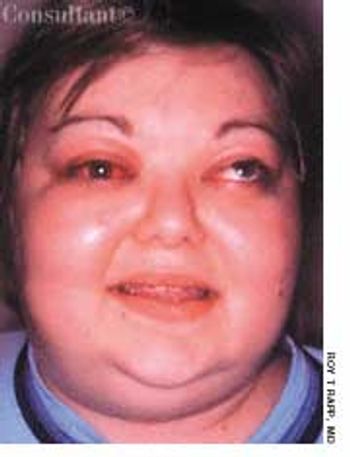
For 1 month, a 25-year-old woman had experienced discomfort in and around the left eye and diplopia. She was in good health; she reported no weight loss, excessive nervousness, heat intolerance, decreased strength, changes in the texture of hair or skin, or altered bowel habits. There was no personal or family history of goiter or other thyroid disease.

A pruritic rash developed on the feet of a 40-year-old woman 2 days after she had worn a new pair of shoes for a few hours. The erythematous, papular, scaly eruption was more prominent on the right foot.

For 2 days, a 43-year-old woman has had a slightly tender rash on her trunk andextremities. Five days earlier, the patient was given levofloxacin for an upperrespiratory tract infection; because she is prone to yeast infections while takingantibiotics, fluconazole also was prescribed.

A previously healthy elderly woman reports that she has hadunilateral facial pain and crusting skin lesions for several days. She decides toseek medical care because of concomitant impaired visual acuity.

Several of my female patients have chronic itchy, burningvulvitis.

A 75-year-old woman complained of“tired and heavy eyes” and being unableto keep her eyelids open to readat night.
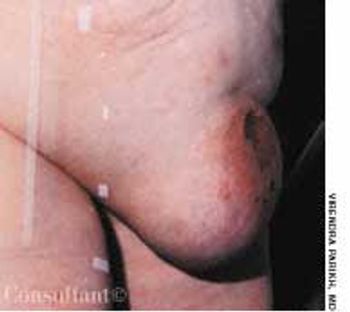
Incarcerated umbilical herniations occur through the umbilical canal that is bordered by the umbilical fascia posteriorly, the linea alba anteriorly, and the medial edges of the 2 rectus sheaths on each side.
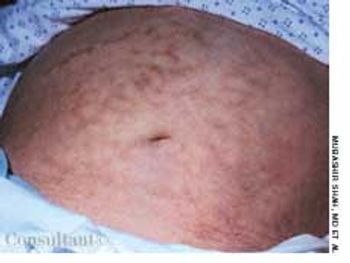
A 62-year-old woman presented with a rash and intermittent pain of the right upper quadrant. The reticular, brown hyperpigmentation was also seen on her right flank and around the umbilicus. The patient reported that she often applied heating pads to these areas for pain relief.

A 63-year-old woman seeks evaluation of a persistent, rough, red area onthe dorsum of her left index finger. The lesion has been present for severalmonths. The patient’s manicurist is convinced it is a wart.

A 37-year-old woman complains of “itchy bumps” that erupted just above herwaist 2 or 3 days earlier. She denies having had this condition in the past.The patient is otherwise healthy and takes no medications. An avid gardener,she claims to be able to identify and avoid poisonous plants.